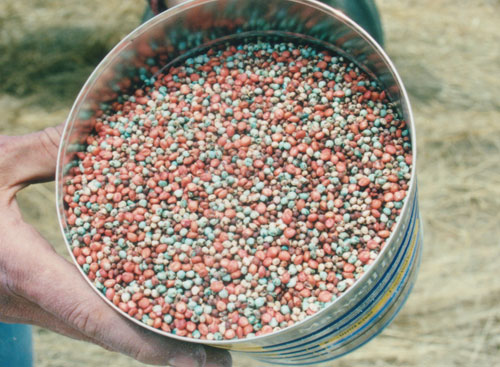Deer Food Plot Seed
Hunters and landowners interested in wildlife management understand that annual food plots are a great way to supplement the diets of wild animals. However, many are confused when it comes to finding and purchasing food plot seed for deer and other wildlife. This is because a wide variety of plants can be seeded to food plots to attract target species, whether they be game or non-game. In most cases, however, hunters are searching for deer food plot seed. More food plots are developed for white-tailed deer than any other wildlife species.
When it comes to planting and establish winter and summer food plots for whitetail deer and wild turkey nothing is more important that obtaining high quality food plot seed. Although seeds can be costly, they are not nearly as costly as the time, energy, and equipment it takes to work a plot each season. In short, landowners and managers should not skimp when it comes to seed.

Of course, you should not subject yourself to getting raked over the coals either. Costly food plot mixes are often great, but that does not mean you can not get the same thing for a lower price. But time is money, so spend the money for good deer food plot seed or do your research.
Plot Seed for Deer & Other Wildlife
One of the most common deer food plot seeds are those classified as small grains. These seeds include oats, wheat, and ryegrass and are typically planted to winter food plots. Ryegrass has good protein levels and is highly desirable to deer during the early season, but it is not until later in the season that ryegrass really begins to grow.
Unfortunately, ryegrass is not nearly as palatable to whitetail deer in late winter at southern latitudes. Oat and wheat seed make excellent cool season whitetail deer food plots because they will grow in just about any soil type, provide good maintenance nutrition, they are relatively inexpensive for deer food plot seeds and they are readily available.
Forbs are Great Food Plot Seed
Other popular deer food plot seeds are those of plants classified as forbs. These seeds are more expensive than the small grains because they are not grown commercially for human food production. Forb seeds used for food plots are grown commercially specifically for sale as whitetail deer food plot seeds. They are more difficult to grow and harvest and the seeds are quite small. It’s just a more labor intensive operation.
These forb plants include Austrian winter peas, lab lab, vetch, cowpeas, brassicas (rape) and clovers. Austrian winter peas, brassicas and clovers are used for winter food plots while lab lab, vetch and cowpeas are commonly found in spring and summer food plots. There are many varieties of vetches used for deer food plots, but the common ones are American jointvetch and hairy vetch.
The seeds of these forbs are not terribly difficult to find, but they are more expensive than the small grains. That being said, these produce superior food plots because of the whitetail nutrition they provide.
Deer Food Plot Seed: Clover
In addition to small grain seeds and forb seeds, another common food plot seed, which I consider different from the others, is that of the clovers. Clovers make great whitetail deer food plots and different varieties can be planted during both the spring/summer and fall/winter. The seeds of red clover, crimson clover, subterranean clover and Ladino clover can be planted to winter food plots. The seeds of Alyce clover can be planted to into a single species summer food plot or combined with other species into a food plot seed mix.
Clovers are different than other plants because they are legumes. This means that they can take nitrogen from the air if the proper bacteria are present in the soil. That said, many soils do not have the bacteria, so it recommended that landowners add the bacteria to the clover seed before it is planted to a deer food plot. This is called “inoculating” the clover seed. Clover inoculum can be purchased where you buy your seed or you can buy pre-inoculated seeds.
Common Food Plot Seeds
Other plants commonly used for deer and turkey food plots include corn, milo, millet and soybeans. The seeds of these species should be planted in the spring for supplemental forage during the spring and summer. These plant species and the small grains can be planted individually or put into a food plot mix. To plant, broadcast them as evenly as possible over the seedbed and lightly disk to cover seeds about 1 inch deep.
Forb and clover seeds not be covered very much and I recommend covering with only 1/4 of soil. A drag made from a piece of chain-link fence or cattle panel will do a great job.
There are quite a few options for each season when it comes to whitetail deer food plot seeds. Keep in mind, however, that each plant is different and should be evaluated for your situation. Make sure to test the soil and prepare a proper seed bed or you will likely be disappointed with your wildlife food plot. Choosing the right food plot seed is not difficult but it does take know your objectives, your soil, and planning in advance to be successful.